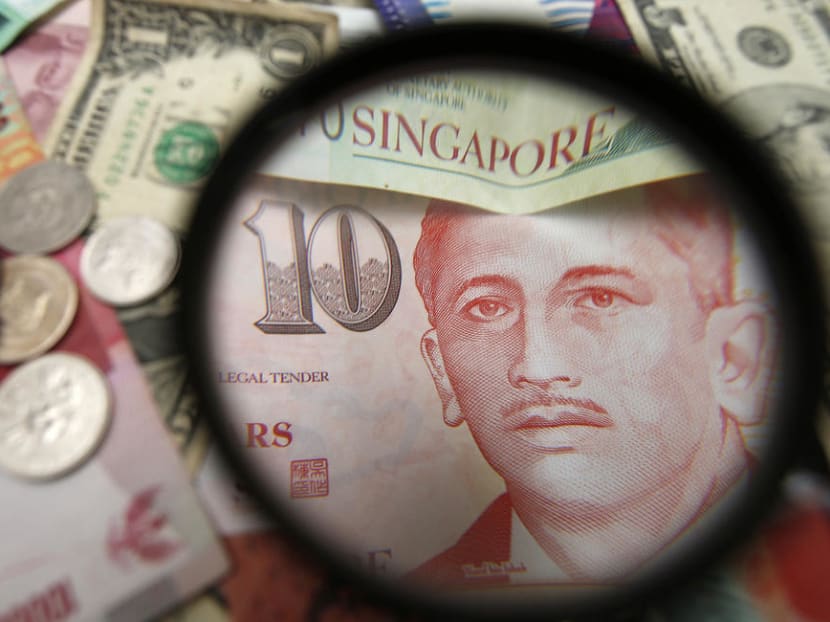Explainer: Why living costs look set to increase in 2022
SINGAPORE — As a small nation highly exposed to the vagaries of the global economy, Singapore is, and always has been, a “price-taker”. In other words, it must accept prevailing market prices set by global forces.

Various factors both global and domestic are driving up inflationary pressures, which could mean Singapore consumers will pay more for goods and services in 2022.
- Inflation is expected to pick up in 2022 as the global economic recovers
- Global supply chain issues, climate change and Singapore’s tightening labour market may lead to inflation
- That means prices of goods and services such as healthcare and imported goods could go up
- Food prices could climb more than 26 per cent in 2021 alone, the World Bank said
- It is still not yet clear what the long-term dynamics of inflation will be for the Covid-19 pandemic
SINGAPORE — As a small nation highly exposed to the vagaries of the global economy, Singapore is, and always has been, a “price-taker”. In other words, it must accept prevailing market prices set by global forces.
With the world still mired in the ebbs and flows of Covid-19, a confluence of global events such as the energy crisis and supply chain shocks is placing upwards pressure on the cost of living here and in many places around the world.
This, coupled with domestic forces such as the expected increase in labour costs and other fee increases next year, could mean that prices could keep on spiralling upwards if left unchecked.
That is why the Monetary Authority of Singapore (MAS), which closely tracks inflation as part of its mandate, uses its monetary policy to keep inflation levels within limits. Earlier this month, it tightened monetary policy in anticipation of higher inflationary pressures next year.
It expects core inflation for next year to fall between 1 and 2 per cent next year, up from the 0 to 1 per cent forecast range for inflation in 2021.
Core inflation excludes big ticket and infrequent purchases such as accommodation and private transport costs, and is thus a useful metric to tell the cost of daily living.
Inflation has already trended up in recent months. For the third consecutive month, core inflation accelerated to 1.2 per cent year-on-year for the month of September, up from 1.1 per cent in August, data released on Monday (Oct 25) showed.
In the third quarter this year, core inflation rose to 1.1 per cent year-on-year, up from 0.7 per cent in the second quarter.
This level of inflation is not considered problematic but if inflationary pressures are left unchecked, resultant higher levels of inflation can spell major economic woe.
To understand why prices of food, goods and some services may go up even further in the months and years ahead, here is what you need to know.
WHAT IS CAUSING HIGHER INFLATION?
The arrival of Covid-19 vaccines earlier this year signalled the first major step towards global economic recovery, though fresh waves of infections due to the Delta variant of the coronavirus delayed this process in the second and third quarter the year.
With vaccination rates climbing globally, life in many countries is returning to some semblance of normality. Economies are back on track towards recovery, even as the total number of new infection cases popping up around the world each day is around the same as it was a year ago.
What this means for prices is that there is a sudden release of pent-up demand as people look to spend, whether on discretionary spending such as travel, electronic devices or recreation, or on necessities such as food.
However, this increase in demand is not matched by increased production due to supply-side constraints that remain.
Higher costs of imported goods
In its twice-yearly macroeconomic policy review on Thursday, MAS noted how global demand for a range of consumer goods such as home electronics and automobiles has been strong, though bottlenecks in global production and logistics have persisted.
Production costs of electronics have also skyrocketed with the high prices of semiconductors, which are facing a global chip shortage. These shortages could last another year, which means that prices of consumer electronics will likely remain high.
Transport and shipping costs have also risen, which has led to a significant increase in global export prices that are passed on to consumers.
The Freightos Baltic Global Container Index, which tracks the cost of freight, was seven times higher last month than at the end of 2019.
Causes of this price jump include the persistent lack of supply of container ships, abnormally long processing times at ports due to container backlogs and pandemic-induced worker shortages, as well as energy price spikes.
These disruptions would likely take some time to resolve, since some depend on the uptake of vaccines in affected countries, which could pick up by early next year, MAS said.
Higher food costs
Climate effects had translated to a steady rise in global food commodity prices in the past few quarters, MAS said.
In the third quarter this year, food prices were 33 per cent above their pre-pandemic levels in 2019.
Adverse weather conditions in global corn and soybean growing regions have lifted prices of animal feed, resulting in record high production costs for livestock such as poultry in Malaysia, it added.
The situation is felt globally as well, with the World Bank estimating that food commodity prices will surge by 26.1 per cent this year. In comparison, food prices declined by 0.8 per cent on average in the decade before the pandemic.
As a result, Singapore’s non-cooked food inflation rose to 1.2 per cent year-on-year in the July-to-August period, compared with 0.4 per cent in the preceding quarter.
MAS added that the ongoing logistics crunch would continue to put upward pressures on food prices.
“Against this backdrop, Singapore’s imported food price inflation is expected to increase further in the coming months,” Singapore’s central bank said.
Uncertainty over energy prices
In recent weeks, gas, coal and electricity prices around the world have also risen to their highest levels in decades, driven by a strong rebound in energy demand that outstripped supply as countries recover from the pandemic.
Despite this, MAS said that the outlook in 2022 could change because crude oil prices are expected to ease next year, assuming that global oil production picks up, among other factors.
However, the recent gas price surge in the midst of a supply crunch could also persist and cause oil prices to go up as well, it added.
The surge in gas prices has already hit the wholesale and retail price of electricity in Singapore, which is heavily dependent on gas-generated energy. This has forced two retailers to exit the market and resulted in higher power bills for some consumers.
The projected easing in crude oil prices over the course of next year is also largely dependent on supply conditions, which are heavily influenced by the production decisions of oil producing nations, it said.
Fee increases
Various service fee increases that had been put on hold due to the pandemic, such as those for transport, healthcare and education, could resume as the economy returns to a firmer footing.
MAS said that public transport fares could be raised as the maximum allowable fare adjustment amount of 4.4 per cent from the previous fare review will be rolled over to the upcoming review next year.
In education, the lower fee caps for preschool education this year should normalise by January next year.
In healthcare, existing outpatient subsidies under the Public Health Preparedness Clinic scheme could also be gradually phased out, which would result in rising healthcare inflation next year, MAS added.
Labour costs to go up
With Singapore’s economy expected to expand and economic activities resume next year, the labour market is likely to tighten over time.
This is already starting to happen. Resident employment expanded by 4,800 in the second quarter this year, which is a slower rate than the 23,700 net hirings seen in the first quarter, suggesting that labour market slack has dissipated.
As a result, wages are expected to rise in 2022 as well, which would translate to more business cost pressures that are likely to be passed on to consumers.
In the food-and-beverage sector, for example, MAS noted that employers are offering higher pay to attract and retain workers due to these cost pressures.
Another factor that could drive up labour costs for businesses is the gradual removal of pandemic-related business support measures.
“Business cost pressures have remained relatively contained to date, but should pick up further next year as government support measures taper and factor market slack declines.
"Indeed, most of the broad-based wage support for businesses had already ceased in the third quarter,” MAS noted.
Possibility of tax increases in 2022
Finance Minister Lawrence Wong announced earlier this month that the Government will be revising the carbon tax rate in the 2022 annual Budget, since the current rate is too low.
There have also been discussions over wealth taxes and other planned tax hikes, such as whether the impending Goods and Services Tax (GST) increase to 9 per cent may happen in 2022.
When the Government last raised the GST from 5 per cent to the present 7 per cent rate in July 2007, headline inflation had gone up by between 0.4 and 0.6 percentage points in both 2007 and 2008, MAS’ report showed.
The timing of the increase of carbon tax and the GST is not yet known, though the GST hike is expected to happen before 2025.
To cushion the impact of such a hike, the Government has set aside a S$6 billion assurance package to offset at least five years’ worth of extra GST expenses for middle-income households, and at least 10 years for low-income families.
LONG-TERM INFLATION
In post-crisis situations, inflation is, by tradition, the inevitable price tag that needs to be paid, following the extraordinary government interventions around the world marked by high amounts of deficit spending and injections of money into the economy through bonds and credit.
These policy interventions went on for more than a decade in the wake of the 2007-08 Global Financial Crisis, when interest rates were at historic lows and central banks such as the US Federal Reserve continued to effectively print vast amounts of money.
Basic monetary theory suggests that an increase in money supply will eventually lead to inflation — something that some advanced economies could already be experiencing. The United States Federal Bank last month projected inflation for the whole of 2021 to be 4.2 per cent. Just 10 months ago, it expected inflation to be 1.8 per cent for the full year.
Simply put, the question for many countries is the timing in which this bill arrives.
Research into inflation dynamics in past pandemics have shown that deflation tends to happen for a number of years, especially for pandemics that drag on. With factories closing down and businesses going under, pandemics can lead to permanent scarring and a loss of production, which is a form of deflationary pressure.
Yet, Covid-19 might be a different sort of pandemic, since both fiscal and monetary authorities worldwide have responded to the crisis with “unprecedented heft”, Dutch Central Bank economists Dennis Bonam and Andra Isabela Smadu said.
“These policies have likely alleviated the adverse economic effects of the pandemic and can even lead to a rise in headline inflation if maintained beyond the health crisis,” they concluded.
All things considered, the long-term effects of the Covid-19 pandemic on global inflation is still uncertain.
It is why MAS concluded the same in a special feature that accompanied its Thursday report — that it is “too soon to tell”.
“The ongoing Covid-19 pandemic, in causing simultaneous demand and supply shocks that are difficult to disentangle, has presented renewed challenges to monetary policy,” it said.











